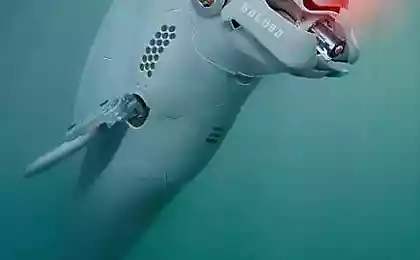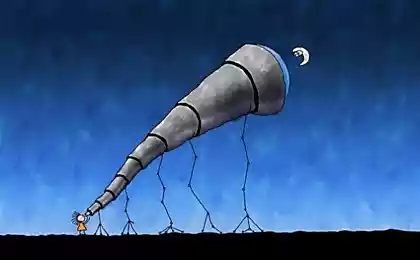522
Looks like the man in the echolocation signals of dolphins
Dolphin has unattainable for man-made devices efficiency hydroacoustic location. He poziruet the bullet, had fallen into the water at a distance of 15m; distinguish the size of objects of the same shape, differing by a few percent of the material; distinguish between like scanner the details of the internal structure of objects in the water or in the sludge, their shape and other parameters, detects edible fish at a distance of three kilometres and different from that which is not used in food.
This is achieved by the perfection of sonar system-the brain. The figure shows a purely schematic structure of the functioning of the sonar of a Dolphin.
According to echolocation signals of dolphins, scientists have been able to figure out how these animals "see" in the water man. Sonar signals recorded with an underwater microphone, was transformed into images. Reported by the Daily Mail.
And here's how it looks ...
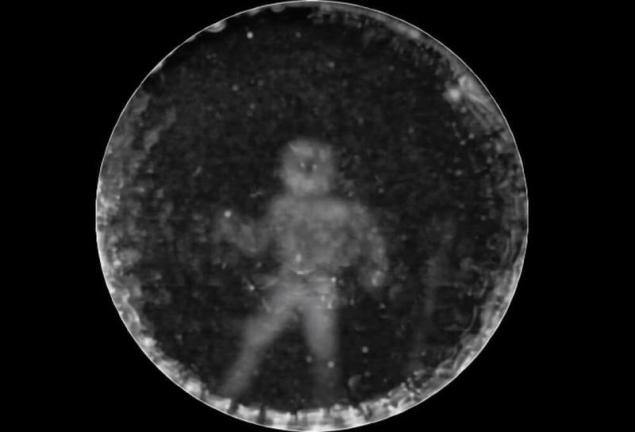
The study was conducted at the Dolphinarium in Puerto Aventuras (Quintana Roo, Mexico). Diver Jim McDonough (Jim McDonough) put on a weight belt and actively exhaled air. It was decided not to use scuba because the bubbles from it would affect the outcome of the experiment. Signals (recorded with a microphone from the echo signals of the Dolphin directed towards McDonough) was transferred to the British scientist John Stuart Reid (John Stuart Reid) — specialist in acoustic physics, founder of the imaging device of sound the CymaScope.
The basic principle of operation — the conversion of sound vibrations into fluctuations of water level. First, scientists have uploaded a sequence of ultrasonic echolocation signals of the Dolphin in CymaScope, putting the camera in the mode of reproduction of the video. On the surface of the water, they saw some strange shape. Then they lost the video back, frame by frame, and after a while saw the vague silhouette of a man. Computer processing of images has brought new details (in particular, the researchers were able to see cargo zone McDonough).
Previously (in 2012) using the same methods biologists have discovered how animals perceive inanimate objects.
Thus, echolocation enables dolphins to "see" not only the shadows of objects, but the shapes of their surfaces. "We think that dolphins can use sound-visual language — the language of symbols, which they share with each other, said study author Casewit Jack (Jack Kassewitz).
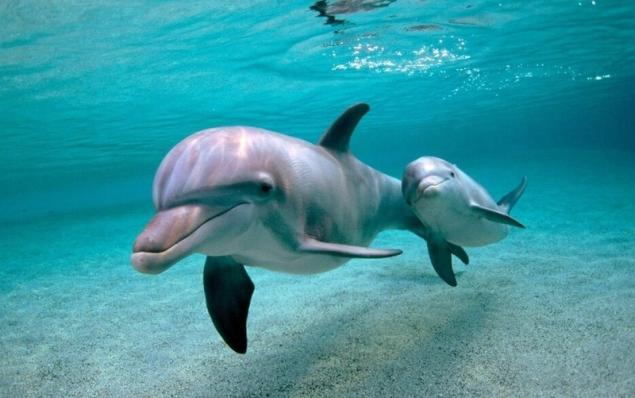
Now let's examine how it works.
Bow channel (1) running from the blowhole to the lungs connects the three pairs of air bags (2), which is a cavity surrounded by a system of radial muscles.
Membrane, located at the junction of the bags with a nasal channel, while blowing the air out of the left bag to the right or Vice versa to generate ultrasonic vibrations that are focused by using reflector (3), which is a parabolic depression in the frontal part of the skull and the acoustic lens (4), which is a fat education is a system of muscles that change if necessary its shape and therefore the focal length.
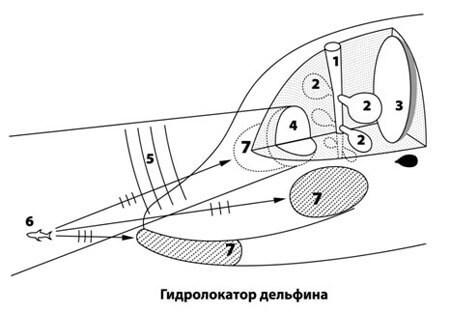
The result is an ultrasound beam (5), the frequency and directivity pattern of which can vary. The observed object 6 scatters incident radiation and perceived antenna system in three regions (7) placed on the skin rostrum and lower jaw of a Dolphin.These areas formed the acoustic receptors of the skin with a distribution density of about 600 units per 1 sq cm and are, in fact, the spatial holographic foster system.
The scheme is purely conditional. Valid form elements is much more complicated. However, the display of these anatomical details only complicate the understanding of the system.
We will make small retreat. The speed of the Dolphin in the water can reach величины50-60 km/hour, which is much higher than its muscular power. For the first time on this fact drew the attention of John gray.
He showed that the aerodynamically shaped solid is the same with a Dolphin of the size and shape would have to invest to overcome the resistance of the water power, about seven times greater than the one he has.
This fact, which was later called "the paradox of gray" due to the fact that the drag coefficient in laminar flow is much lower than in turbulent.
Explain the paradox of the grey features of the structure and functioning of the skin with a hydrophobic and damping properties, as well as the motor mechanism of the skin and the entire body of a Dolphin.
First of all, the skin surface is completely smooth and has hidrofob-owned property (when a Dolphin emerges, his skin no water droplets). The smoothness of the surface is ensured by its constant renewal, sloughing the dying parts, which protects against biological growth, so characteristic of the marine watercraft, and many inhabitants of the seas. This is the first stage of protection to ensure minimal friction.

The second stage of protection provides damping of small-scale pulsations of the pressure of the water environment heralding the formation of turbulence.
For this purpose, the epidermis contains two layers: a thin outer and underlying germ or thorn. In the sprout layer includes elastic spiky papillae of the dermis, which provide a secure grip with shock absorber – layer of fat, pierced a dense plexus of collagen and elastin fibers.
The first and second stage is passive.
Under the layer of fat is a layer of a developed system of subcutaneous muscles and blood vessels. This is the third tier of protection.
A third tier of protection, as follows. The most important condition for the preservation of laminarinase (irrotational flow) is the presence of longitudinal adverse pressure gradient, which prevents the formation of vortices. Once a month-the skin there is a tendency for a positive gradient, muskulaturnoy saturated with blood, the layer immediately changes the shape of the surface of the body of a Dolphin in an appropriate place in such a way that eliminates the trend. It is already active muscular and hydraulic protection.
Information about the pressure field give the respective receptors, covering the entire body of a Dolphin. One of the receptors of touch in animals and humans are hair. Dolphin, having lost the hair of its evolution, has turned what's left of them in these receptors. Field DAV-divisions of the flowing water is analysed in the relevant section of the brain and gives the necessary commands to the autonomic nervous system, the control system of the muscles and blood.
The same role in the preservation of laminarinase flow around a body of a Dolphin playing his tail section, the movement of which create a negative pressure gradient. This is the fourth level of protection.
When a Dolphin needs to reach the maximum possible speed, for example, before the high jump, it includes the fast and the furious, turning the skin into an additional engine. On high-speed filming is clearly seen as the body of the Dolphin in the direction of the tail runs transverse "corrugations" of the protrusions of the skin, which is more of a row movement.
Thus, Dolphin all is the engine of excellence, capable of moving with great speed, while being in a fully laminar flow.
This means, among other things, that he had no noise of flow, which is so rich in technical Maritime resources.
Now, let's finish made the retreat and return to hydroacoustics, knowing that the Dolphin is moving without creating hydrodynamic noise.
The man's body covered by a dense network of receptors of touch. Receptors touch and pressure (mechanoreceptors) in the skin of the person more than 600 thousand. This Pacini corpuscles and Meissner and Merkel disks.

Mechanoreceptors perceive, including vibration and sound. The latter is not their main purpose – there are ears. However, there are cases when childhood deaf people by putting your palms flat on the table or putting feet on the floor, unable to listen to music.
The Dolphin mechanoreceptors, apparently, much more than humans. In the process of evolution they turned into many thousands of hydrophones covering the entire body of a Dolphin. As a result, the surface of the body of a Dolphin is a highly developed multifunction antenna operating in the frequency range from few Hz to 200 kHz with very low noise and having a unique scanning device – the brain.
In other words the entire body of a Dolphin is the perfect acoustic of the eye, which can work both in active and in passive mode with all-round visibility and the ability to focus the maximum resolution in the desired direction.
The difference between the optical and acoustical eye lies only in the fact that in the first case, the analysis information is based on laws of geometrical optics, while the second – on the basis of the laws of acoustic holography.
In the lens system, the only information that can be obtained from one receptor, it is the amplitude of the acoustic pressure. In a holographic system, imaging is used both amplitude and phase. As a holographic antenna carries most of the information from each receptor, the resulting images are more informative. Moreover, because the receptors cover the whole body of the Dolphin, i.e., the antenna has a maximum size, and the resolution it has the maximum achievable value.
Based on the foregoing, let us consider the General scheme of the sonar system of the Dolphin.
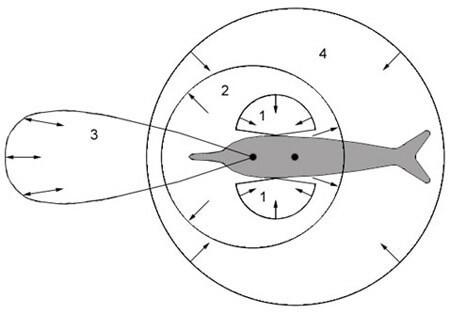
Dolphin as the receiving-emitting hydroacoustic
system.
The first subsystem – the-ears (1), the third complement receptor – jaw. It provides mainly the reception of communication signals, and also provides part of the functions of lighting underwater environment.
The second subsystem – studying all types of sounds in the range of 10 Hz to 196 kHz. Area of its radiation (2).
The third subsystem is a system near sonar works in zone (3) and uses the most high-frequency signals.The same sonar receptors, which with a high density are distributed on the front side, with lower density located on the surface of the whole body of the Dolphin to form a multi-element broadband sonar receiving antenna with a circular radiation pattern (4).
This subsystem of the holographic technique provides lighting underwater environment, working in both active and passive modes, and complements the work of the first subsystem.
A Dolphin can perceive the sounds of this frequency, which he is not able to reproduce, unlike terrestrial mammals and humans who hear the sound, only such frequencies which make themselves.
Dolphin has several sonar systems, partially overlapping and running in parallel.The division of incoming information, and its collaborative processing is carried out with power of the brain in real time.
This ensures a significant improvement of the ratio signal/noise and the connection is directional, providing high spatial resolution, with a circular review, which is conducted in active and in passive mode, which is inaccessible to technical means.
The information received is encoded by the brain, apparently in the form of a four-dimensional images (three spatial and one frequency).
For Dolphin sonar channel information means much more than eyesight for humans. Other senses play a supporting role.
What the Dolphin sees with its sonar system? He sees the surface and sees the bottom with all the details of its structure, including the details of the layers of bedrock; sees the objects lying on the bottom, including lying deep in the mud; see the characteristics of each object, its size, shape, material features, internal structure.
There's nothing he can "say" about any particular subject, if you haven't seen that before. But if there are two similar objects, he with some training, can distinguish one from the other by any parameters: size, shape, material, on-Liceu voids inside, size and shape of these voids, etc.
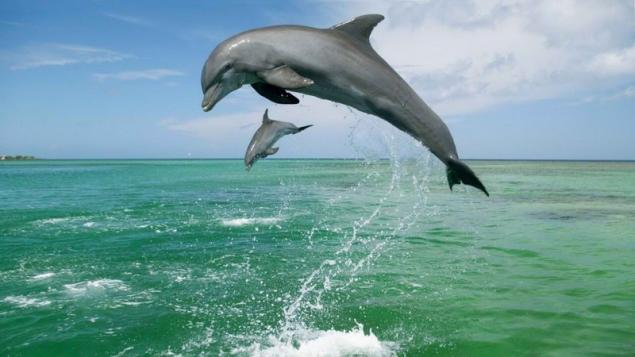
He sees all the floating objects around it (in General, so to say "peripheral vision") and if something interested him, concentrating on the sharpness of your acoustic vision. By the way, when a Dolphin swims or wants to see anything, he does the head movements, very similar to the movement of the pupils of a person in such situations.
A few simple examples. Dolphin distinguishes between: two identical in shape and size, but made one from steel, the other brass; two equally solid machined steel ball with different diameter 2-3%; two identical sealed thick-walled hollow cylinder, the cavity of which is partially filled with water if the difference between the levels of water in them makes 3-4 mm and so on.
A more complex example. If in the water floats a few people, including one familiar Dolphin, the Dolphin will swim to it, if familiarity has a positive connotation. If sailing at the same time, even at a distance, a few familiar people, a trained Dolphin will swim in the case of receiving the command it, to whom it will be provided.
How does it happen? Every underwater object is a transformer of hydroacoustic fields in the surrounding space. At some frequencies is dominated by the reflection of incident on the object waves, for some absorption. Occurs a phase shift and changes the interference structure of the field absorbed by the object, acoustic energy pereslushal them at their own resonant frequencies, etc.
Each Dolphin sonar radiated radar pulse reflected from an object carries information about its position, size and shape (angle and time of arrival of the echo waves). The energy of the pulse, having the form of a Delta function, stimulates the entire range of resonant frequencies of the object, which creates its unique acoustic way.
Basic information Dolphin give active sonars: front (high resolution) and circular (coarse resolution) and passive auditory stereo system receiving ambient acoustic fields.
But perhaps a certain contribution is made by the holographic system operating in a passive mode (without backlight), based on the distortion of objects, interference fields at different frequencies generated by external sources of coherent and broadband background radiation. published
P. S. And remember, only by changing their consumption — together we change the world! © Join us at Facebook , Vkontakte, Odnoklassniki
Source: masterok.livejournal.com/2662826.html
This is achieved by the perfection of sonar system-the brain. The figure shows a purely schematic structure of the functioning of the sonar of a Dolphin.
According to echolocation signals of dolphins, scientists have been able to figure out how these animals "see" in the water man. Sonar signals recorded with an underwater microphone, was transformed into images. Reported by the Daily Mail.
And here's how it looks ...

The study was conducted at the Dolphinarium in Puerto Aventuras (Quintana Roo, Mexico). Diver Jim McDonough (Jim McDonough) put on a weight belt and actively exhaled air. It was decided not to use scuba because the bubbles from it would affect the outcome of the experiment. Signals (recorded with a microphone from the echo signals of the Dolphin directed towards McDonough) was transferred to the British scientist John Stuart Reid (John Stuart Reid) — specialist in acoustic physics, founder of the imaging device of sound the CymaScope.
The basic principle of operation — the conversion of sound vibrations into fluctuations of water level. First, scientists have uploaded a sequence of ultrasonic echolocation signals of the Dolphin in CymaScope, putting the camera in the mode of reproduction of the video. On the surface of the water, they saw some strange shape. Then they lost the video back, frame by frame, and after a while saw the vague silhouette of a man. Computer processing of images has brought new details (in particular, the researchers were able to see cargo zone McDonough).
Previously (in 2012) using the same methods biologists have discovered how animals perceive inanimate objects.
Thus, echolocation enables dolphins to "see" not only the shadows of objects, but the shapes of their surfaces. "We think that dolphins can use sound-visual language — the language of symbols, which they share with each other, said study author Casewit Jack (Jack Kassewitz).

Now let's examine how it works.
Bow channel (1) running from the blowhole to the lungs connects the three pairs of air bags (2), which is a cavity surrounded by a system of radial muscles.
Membrane, located at the junction of the bags with a nasal channel, while blowing the air out of the left bag to the right or Vice versa to generate ultrasonic vibrations that are focused by using reflector (3), which is a parabolic depression in the frontal part of the skull and the acoustic lens (4), which is a fat education is a system of muscles that change if necessary its shape and therefore the focal length.

The result is an ultrasound beam (5), the frequency and directivity pattern of which can vary. The observed object 6 scatters incident radiation and perceived antenna system in three regions (7) placed on the skin rostrum and lower jaw of a Dolphin.These areas formed the acoustic receptors of the skin with a distribution density of about 600 units per 1 sq cm and are, in fact, the spatial holographic foster system.
The scheme is purely conditional. Valid form elements is much more complicated. However, the display of these anatomical details only complicate the understanding of the system.
We will make small retreat. The speed of the Dolphin in the water can reach величины50-60 km/hour, which is much higher than its muscular power. For the first time on this fact drew the attention of John gray.
He showed that the aerodynamically shaped solid is the same with a Dolphin of the size and shape would have to invest to overcome the resistance of the water power, about seven times greater than the one he has.
This fact, which was later called "the paradox of gray" due to the fact that the drag coefficient in laminar flow is much lower than in turbulent.
Explain the paradox of the grey features of the structure and functioning of the skin with a hydrophobic and damping properties, as well as the motor mechanism of the skin and the entire body of a Dolphin.
First of all, the skin surface is completely smooth and has hidrofob-owned property (when a Dolphin emerges, his skin no water droplets). The smoothness of the surface is ensured by its constant renewal, sloughing the dying parts, which protects against biological growth, so characteristic of the marine watercraft, and many inhabitants of the seas. This is the first stage of protection to ensure minimal friction.

The second stage of protection provides damping of small-scale pulsations of the pressure of the water environment heralding the formation of turbulence.
For this purpose, the epidermis contains two layers: a thin outer and underlying germ or thorn. In the sprout layer includes elastic spiky papillae of the dermis, which provide a secure grip with shock absorber – layer of fat, pierced a dense plexus of collagen and elastin fibers.
The first and second stage is passive.
Under the layer of fat is a layer of a developed system of subcutaneous muscles and blood vessels. This is the third tier of protection.
A third tier of protection, as follows. The most important condition for the preservation of laminarinase (irrotational flow) is the presence of longitudinal adverse pressure gradient, which prevents the formation of vortices. Once a month-the skin there is a tendency for a positive gradient, muskulaturnoy saturated with blood, the layer immediately changes the shape of the surface of the body of a Dolphin in an appropriate place in such a way that eliminates the trend. It is already active muscular and hydraulic protection.
Information about the pressure field give the respective receptors, covering the entire body of a Dolphin. One of the receptors of touch in animals and humans are hair. Dolphin, having lost the hair of its evolution, has turned what's left of them in these receptors. Field DAV-divisions of the flowing water is analysed in the relevant section of the brain and gives the necessary commands to the autonomic nervous system, the control system of the muscles and blood.
The same role in the preservation of laminarinase flow around a body of a Dolphin playing his tail section, the movement of which create a negative pressure gradient. This is the fourth level of protection.
When a Dolphin needs to reach the maximum possible speed, for example, before the high jump, it includes the fast and the furious, turning the skin into an additional engine. On high-speed filming is clearly seen as the body of the Dolphin in the direction of the tail runs transverse "corrugations" of the protrusions of the skin, which is more of a row movement.
Thus, Dolphin all is the engine of excellence, capable of moving with great speed, while being in a fully laminar flow.
This means, among other things, that he had no noise of flow, which is so rich in technical Maritime resources.
Now, let's finish made the retreat and return to hydroacoustics, knowing that the Dolphin is moving without creating hydrodynamic noise.
The man's body covered by a dense network of receptors of touch. Receptors touch and pressure (mechanoreceptors) in the skin of the person more than 600 thousand. This Pacini corpuscles and Meissner and Merkel disks.

Mechanoreceptors perceive, including vibration and sound. The latter is not their main purpose – there are ears. However, there are cases when childhood deaf people by putting your palms flat on the table or putting feet on the floor, unable to listen to music.
The Dolphin mechanoreceptors, apparently, much more than humans. In the process of evolution they turned into many thousands of hydrophones covering the entire body of a Dolphin. As a result, the surface of the body of a Dolphin is a highly developed multifunction antenna operating in the frequency range from few Hz to 200 kHz with very low noise and having a unique scanning device – the brain.
In other words the entire body of a Dolphin is the perfect acoustic of the eye, which can work both in active and in passive mode with all-round visibility and the ability to focus the maximum resolution in the desired direction.
The difference between the optical and acoustical eye lies only in the fact that in the first case, the analysis information is based on laws of geometrical optics, while the second – on the basis of the laws of acoustic holography.
In the lens system, the only information that can be obtained from one receptor, it is the amplitude of the acoustic pressure. In a holographic system, imaging is used both amplitude and phase. As a holographic antenna carries most of the information from each receptor, the resulting images are more informative. Moreover, because the receptors cover the whole body of the Dolphin, i.e., the antenna has a maximum size, and the resolution it has the maximum achievable value.
Based on the foregoing, let us consider the General scheme of the sonar system of the Dolphin.

Dolphin as the receiving-emitting hydroacoustic
system.
The first subsystem – the-ears (1), the third complement receptor – jaw. It provides mainly the reception of communication signals, and also provides part of the functions of lighting underwater environment.
The second subsystem – studying all types of sounds in the range of 10 Hz to 196 kHz. Area of its radiation (2).
The third subsystem is a system near sonar works in zone (3) and uses the most high-frequency signals.The same sonar receptors, which with a high density are distributed on the front side, with lower density located on the surface of the whole body of the Dolphin to form a multi-element broadband sonar receiving antenna with a circular radiation pattern (4).
This subsystem of the holographic technique provides lighting underwater environment, working in both active and passive modes, and complements the work of the first subsystem.
A Dolphin can perceive the sounds of this frequency, which he is not able to reproduce, unlike terrestrial mammals and humans who hear the sound, only such frequencies which make themselves.
Dolphin has several sonar systems, partially overlapping and running in parallel.The division of incoming information, and its collaborative processing is carried out with power of the brain in real time.
This ensures a significant improvement of the ratio signal/noise and the connection is directional, providing high spatial resolution, with a circular review, which is conducted in active and in passive mode, which is inaccessible to technical means.
The information received is encoded by the brain, apparently in the form of a four-dimensional images (three spatial and one frequency).
For Dolphin sonar channel information means much more than eyesight for humans. Other senses play a supporting role.
What the Dolphin sees with its sonar system? He sees the surface and sees the bottom with all the details of its structure, including the details of the layers of bedrock; sees the objects lying on the bottom, including lying deep in the mud; see the characteristics of each object, its size, shape, material features, internal structure.
There's nothing he can "say" about any particular subject, if you haven't seen that before. But if there are two similar objects, he with some training, can distinguish one from the other by any parameters: size, shape, material, on-Liceu voids inside, size and shape of these voids, etc.

He sees all the floating objects around it (in General, so to say "peripheral vision") and if something interested him, concentrating on the sharpness of your acoustic vision. By the way, when a Dolphin swims or wants to see anything, he does the head movements, very similar to the movement of the pupils of a person in such situations.
A few simple examples. Dolphin distinguishes between: two identical in shape and size, but made one from steel, the other brass; two equally solid machined steel ball with different diameter 2-3%; two identical sealed thick-walled hollow cylinder, the cavity of which is partially filled with water if the difference between the levels of water in them makes 3-4 mm and so on.
A more complex example. If in the water floats a few people, including one familiar Dolphin, the Dolphin will swim to it, if familiarity has a positive connotation. If sailing at the same time, even at a distance, a few familiar people, a trained Dolphin will swim in the case of receiving the command it, to whom it will be provided.
How does it happen? Every underwater object is a transformer of hydroacoustic fields in the surrounding space. At some frequencies is dominated by the reflection of incident on the object waves, for some absorption. Occurs a phase shift and changes the interference structure of the field absorbed by the object, acoustic energy pereslushal them at their own resonant frequencies, etc.
Each Dolphin sonar radiated radar pulse reflected from an object carries information about its position, size and shape (angle and time of arrival of the echo waves). The energy of the pulse, having the form of a Delta function, stimulates the entire range of resonant frequencies of the object, which creates its unique acoustic way.
Basic information Dolphin give active sonars: front (high resolution) and circular (coarse resolution) and passive auditory stereo system receiving ambient acoustic fields.
But perhaps a certain contribution is made by the holographic system operating in a passive mode (without backlight), based on the distortion of objects, interference fields at different frequencies generated by external sources of coherent and broadband background radiation. published
P. S. And remember, only by changing their consumption — together we change the world! © Join us at Facebook , Vkontakte, Odnoklassniki
Source: masterok.livejournal.com/2662826.html





